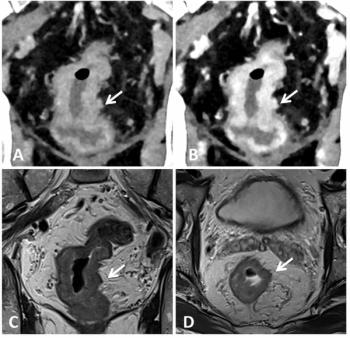
Researchers advocate greater use of breast MR for screening Asian women
Breast MRI may be particularly beneficial as a screening tool for Asian women, and its improved sensitivity and specificity are boosting cancer detection rates, according to a Taiwanese poster presentation.
A 52-year-old woman had a right mastectomy because of lobular carcinoma three years previously. MRI (top) shows multicentric irregular nodular lesions demonstrating intense and early contrast enhancement. Mammography (middle) was negative. Of the ultrasound scans, only one lesion showed suspicious findings. The pathological diagnosis was recurrent multicentric lobular carcinoma on contralateral breast. (Provided by Dr. James Ko)
Breast MRI may be particularly beneficial as a screening tool for Asian women, and its improved sensitivity and specificity are boosting cancer detection rates, according to a Taiwanese poster presentation.
The clinical value of breast MR as a screening tool is often questioned due to its inability to depict microcalcifications, which are readily seen on mammography. The accuracy of mammography, however, can be hampered by dense fibroglandular tissue, a finding typical among the Asian population.
"Asian women in general have dense glandular breasts with little fat, even after menopause," said Dr. James Ko, a researcher from the VGH-HT Imaging Center in Taipei's Veterans General Hospital (VGH). "Breast MRI has the advantage of examining breasts systematically and reflecting the angiogenic activity concealed in the breasts, aside from morphological assessment."
Between October 2000 and September 2006, breast MR screening was carried out at VGH on 2226 women who had self-referred. The MRI protocol included a high temporal resolution dynamic contrast-enhanced study for kinetic analysis and high spatial resolution images for morphological assessment. A thorough ultrasound examination was conducted at the same time for all the women to provide guidance for needle biopsy, in case it was necessary. The MR and ultrasound findings were carefully compared and correlated. A follow-up mammogram was performed for those patients with suspicious MR results, and was reviewed independently by two radiologists.
Among the sample, there were nine cases of ductal carcinoma in situ and 20 cases of invasive cancer, 13 of which were epithelial hyperplasia showing cellular atypia. Of the invasive lesions, 12 were nonpalpable; of the DCIS, six were nonpalpable.
The age of the women ranged from 46 to 63 years, and the mean was 51.6. The incidence of malignancy in the asymptomatic group was about 1.3%, increasing to 1.9% if the cases of epithelial hyperplasia were included. The mean size for invasive cancer was 14.7 mm, and for DCIS was 9.5 mm. Almost all the lesions demonstrated early and intense contrast enhancement with variable morphological features associated with malignancy on MRI, Ko noted.
All the lesions but two were identified on ultrasound. Five cases were found on second-look after the lesion map had been acquired on MRI. Mammograms were obtained for 13 cases in the invasive cancer group and eight cases from the DCIS group. Only two out of 13 invasive cancers had suspicious findings on mammography. In the DCIS group, two out of eight lesions had presented focal nodules on mammography. None of the lesions showed the typical clustered microcalcifications.
The Taiwanese study did not address cost-effectiveness issues, however.
Newsletter
Stay at the forefront of radiology with the Diagnostic Imaging newsletter, delivering the latest news, clinical insights, and imaging advancements for today’s radiologists.



























